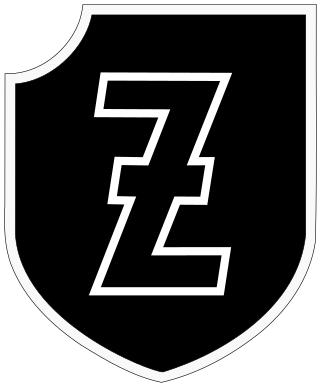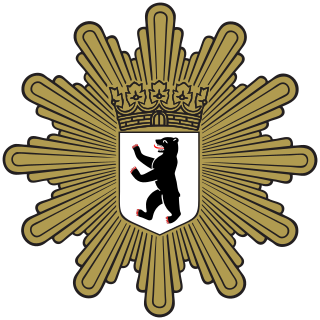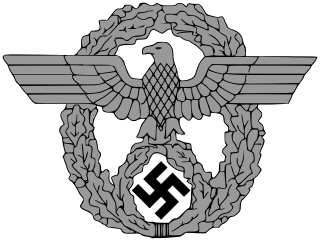
The Ordnungspolizei, abbreviated Orpo, meaning "Order Police", were the uniformed police force in Nazi Germany from 1936 to 1945. The Orpo organisation was absorbed into the Nazi monopoly on power after regional police jurisdiction was removed in favour of the central Nazi government. The Orpo was controlled nominally by the Interior Ministry, but its executive functions rested with the leadership of the SS until the end of World War II. Owing to their green uniforms, Orpo were also referred to as Grüne Polizei. The force was first established as a centralised organisation uniting the municipal, city, and rural uniformed police that had been organised on a state-by-state basis.

The 4th SS Polizei Panzergrenadier Division or SS Division Polizei was one of the thirty-eight divisions fielded as part of the Waffen-SS during World War II.

Landespolizei is a term used to refer to the state police of any of the states of Germany.
Polizei is the German word for police. Police in Germany, Austria and Switzerland consist of different agencies. It might refer to:

The Feldjägerkorps was a military police organization in the German Wehrmacht during World War II. It was formed on 27 November 1943 from distinguished veterans and Patrol Service personnel. This corps was formed into three Feldjäger Commands, which reported directly to Field Marshal Keitel, and was senior to all other military police organizations.

The Feldgendarmerie were a type of military police units of the armies of the Kingdom of Saxony, the German Empire and Nazi Germany until the conclusion of World War II in Europe.

The Wasserschutzpolizei is the river police that patrols the waterways, lakes and harbours of Germany around the clock. The WSP are part of the Landespolizei. The Federal Police maintains 16 patrol craft and helicopters are part of the Coast Guard (Küstenwache) and assigned to coastal BPOL stations. The watercraft include six offshore patrol vessels, e.g. those of the Bad Bramstedt class, as well as a number of fast inshore vessels and one tugboat.
Schutzmannschaft Battalion 202 was a failed collaborationist auxiliary police battalion in the General Government during World War II. It was made up of 360 conscripts with German leadership. The unit was created in Kraków on March 27, 1942 with recruitment beginning in May. Only two Polish men volunteered. As a result, the Germans resorted to conscription from the regular Polish city-police called Einheimische Polizei. Once in Volhynia, the battalion stationed in Łuck originally. Soon later, in around Kostopol, half the members deserted to Polish resistance 27th Home Army Infantry Division, in defence of ethnic Polish population against the UPA massacres, and also committed a number of crimes against the civilian population, participating in the pacification of Ukrainian villages. Additional 60 Poles were rounded up and executed by the Nazis for mutiny.

The Hamburg Police is the German Landespolizei force for the city-state of Hamburg. Law enforcement in Germany is divided between federal and state (Land) agencies. A precursor to the agency, the Polizei-Behörde, has existed since 1814.

Willy Riedel was a highly decorated Major in the Wehrmacht during World War II. He was also a recipient of the Knight's Cross of the Iron Cross with Oak Leaves. The Knight's Cross, and its variants were the highest awards in the military and paramilitary forces of Nazi Germany during World War II. He was severely wounded in early 1943 by a grenade splinter and taken prisoner of war by the Soviet Army. Following World War II, he served in the National People's Army of East Germany.

The Berlin Police is the Landespolizei force for the city-state of Berlin, Germany. Law enforcement in Germany is divided between federal and state (Land) agencies.

Gemeindepolizei (GemPo) is the German name for a municipal law enforcement agency. This article deals with the municipal police forces of Nazi Germany. Municipalities with more than 2,000 residents, not having a state police presence, had to have a municipal police department. The mayors were police commissioners. Under them the municipal police departments were led by professional chiefs of police. Towns with over 10,000 residents having a municipal police department were also obliged to have a municipal criminal investigation division.
The 1st SS Police Regiment was initially named the 1st Police Regiment when it was formed in 1942 from existing Order Police (Ordnungspolizei) units for security duties in Occupied Europe. It was redesignated as an SS unit in early 1943. Later that year it was disbanded and its battalions were reassigned to other SS Police units. The regiment was reformed in late 1944 in Hungary, but was absorbed by 35th SS and Police Grenadier Division in early 1945.
Kriminalpolizei, often abbreviated as Kripo, is the German name for a criminal investigation department. This article deals with the agency during the Nazi era.
The 5th SS Police Regiment was initially named the 5th Police Regiment when it was formed in 1942 from existing Order Police (Ordnungspolizei) units for security duties in Occupied Serbia. It was redesignated as an SS unit in early 1943. The regiment was disbanded at the end of 1944.
The 11th SS Police Regiment was initially named the Police Regiment for Special Employment when it was formed around the beginning of 1942 from existing Order Police units for security duties on the Eastern Front. The unit was renumbered as the 11th Police Regiment in July 1942 and then was redesignated as an SS unit in early 1943.
The 12th SS Police Regiment was initially named the 12th Police Regiment when it was formed in 1942 from existing Order Police units (Ordnungspolizei) in Germany. It was redesignated as an SS unit in early 1943. The regimental headquarters was disbanded in early 1944, but its battalions remained in service.
Luftschutzpolizei (LSP)(Air Raid Protection Police) was the local civil defense organization in Nazi Germany.

The Bremen State Police is the state police force of the Free Hanseatic City of Bremen. It employs around 2,500 officers. The agency is headed by police chief Dirk Fasse; the political head is the Senator for the Interior Ulrich Mäurer.
















